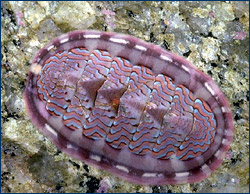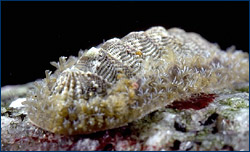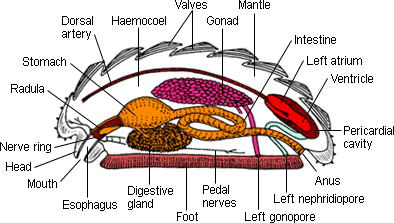Lophotrochozoa : Mollusca
The Polyplacophora
Chitons, the eight-shelled molluscs
|
No. of described species: 650-800
First appearance: Late Cambrian
Habitats: marine, mostly intertidal
Shapes: flat, with eight-valved shells
Feeding types: carnivores and grazers |
 |
Chitons are the familiar group of organisms that have eight valves on their shells. A visit to any rocky intertidal habitat around the world will introduce one to these beautiful molluscs.
 |

A Lined Chiton (Tonicella lokii). |
Though chitons are important members of the molluscan clade, occupying a basal position in the phylogeny, and have interesting diversity and life history traits, our knowledge of the group is spartan in comparison to other mollusc clades.
All chitons are marine and the group has a worldwide distribution. Most live in the rocky intertidal zone or shallow sublittoral (just below the low tide level), but some live in deep water to more than 7000 m. A few species are associated with algae and marine plants, and in the deep sea, waterlogged wood is a common habitat for one group.

A Mossy Chiton (Mopalia muscosa). |
 |
Chitons are generally dioecious (have separate males and females), with sperm released by males into the water. In most chitons, fertilized eggs are shed singly or in gelatinous strings, and once fertilized in the water column, these develop into a trochophore larva (free-swimming and ciliated) that soon elongates and then directly develops into a juvenile chiton; there is no veliger stage (having a velum, a lobed, ciliate swimming organ). In brooding species, the eggs remain in the pallial cavity of the female where they are fertilized by sperm moving through with the respiratory currents. Upon hatching from the brooded eggs, the offspring may remain in the pallial cavity until they crawl away as young chitons or exit the pallial cavity as trochophores for a short pelagic phase before settling.
Chitons are flattened, elongately-oval, with eight overlapping dorsal shell plates or valves, bordered by a thick girdle formed from the mantle that may be covered with spines, scales, or hairs. The pallial cavity, containing multiple pairs of small gills, surrounds the foot with which the animal typically clings to hard surfaces. The plates are greatly reduced or even internal in a few species, these species sometimes having an elongate, somewhat worm-like body. Most are small (0.5-5 cm, but one species reaches over 30 cm in length).
Chitons possess a heart and an open blood system, a pair of kidneys that open to the pallial cavity, a simple nervous system with two pairs of lateral nerve cords, and many special minute sensory organs (aesthetes) that pass through the shell valves. Some of these are specialized as light receptors, having a minute lens and retina-like structure. The mouth is surrounded by a simple velum and the head lacks tentacles or eyes. They feed on encrusting organisms such as sponges and bryozoans, and non-selectively on diatoms and algae that are scraped from the substrate with their radula, which is hardened by the incorporation of metallic ions. One group captures small crustaceans by trapping them under the anterior part of their body.



